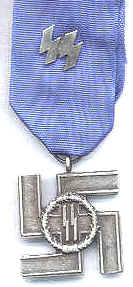| SS Long Service Award SS-Dienstauszeichnungen | |
|---|---|
 12 year award | |
| Type | Medal |
| Awarded for | Long service in the Schutzstaffel |
| Presented by | Nazi Germany |
| Motto | Für treue dienste in der SS |
| Status | Obsolete |
| Established | 30 January 1938 |
| Final award | 1941 |
SS Long Service Awards (German : SS-Dienstauszeichnungen) were medals that were given in grades of four years, eight years, twelve years, and twenty-five years. The four and eight-year service awards were in the form of circular medals while the 12 and 25-year service awards were in the form of swastikas. The SS service awards were designed in Munich by Professor Karl Diebitsch. The awards varied in design depending on the length of service of the recipient. [1]







